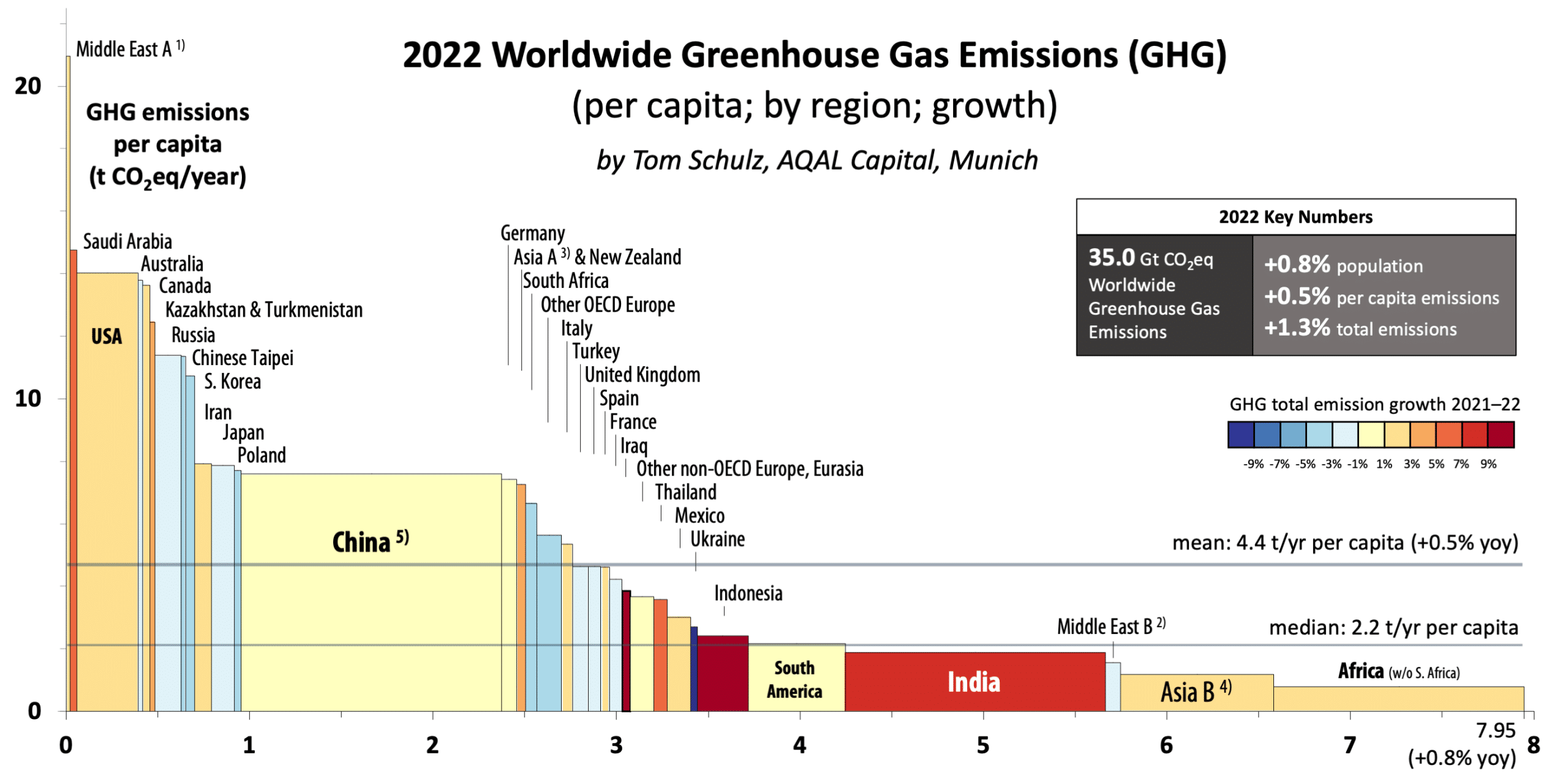
based on IEA (2024), “Greenhouse gas emissions from energy”;
click image to enlarge; click here to download a PDF
Global Anthropogenic Greenhouse Gas (GHG) Emissions Resumed Growth in 2022
GHG emissions resumed growth in 2022, increasing by 1.3% over 2021 levels to reach 35.0 Gt CO2eq. This increase was due to emissions from nearly all countries whereby population growth accounted for 0.8% of the increase, while higher per capita emissions added another 0.5% (view our 2021 variwide chart for contrast).
One Planet, Many Emissions: The Great GHG Divide
In 2022, the global average per capita greenhouse gas (GHG) emissions rose by 0.5% to 4.4 t CO2eq. A stark division persists, with half of the world’s population emitting less than 2.2 t per capita—significantly lower than the global average. This disparity emphasizes the uneven distribution of emissions, exemplified by Germany’s per capita emissions of 7.4 t, which exceeds the global average by 70% and the median by 3.4 times.
Qatar vs. Yemen: The Extreme Ends of Emissions
Per capita emissions diverge widely across regions. Qatar tops developed nations with 34 t per capita, while countries like Yemen emit as little as 0.25 t. Within the OECD, Americans and Canadians emit about 14 t per capita, 2.5 times more than their European counterparts, who average 5.6 t. At 7.6 t, China surpasses the global average, placing its emissions level on par with Germany.
France vs. Germany: Nuclear Power vs. Fossil Fuels in GHG Race
Adjacent countries also demonstrate sharp contrasts in emissions. Germany’s 7.4 t per capita outpaces France’s 4.2 t, echoing disparities in energy strategies—nuclear reliance in France versus Germany’s unrelenting use of oil, coal, and gas.
Economic Development within the Net-zero Framework and Honoring Planetary Boundaries
Regions like India, South America, and Africa remain below the global average in per capita emissions, but their speedy economic and demographic growth is elevating their emissions. A rise in these countries’ per capita emissions to the global average would increase worldwide emissions by 40%. To secure a sustainable future, such growth must align with achieving net-zero targets while respecting planetary boundaries globally.
by Thomas Schulz and Mariana Bozesan, AQAL Capital GmbH, Munich
How to understand the variwide chart
This type of visualization answers immediately questions like
- “Which countries are the largest GHG emitters?”
- “How significant is the spread between per capita emissions in different countries?”
- “Which countries are reducing their GHG emissions?”
- “Which countries are still increasing their GHG emissions?”
- What are the world’s average per capita GHG emissions (arithmetic mean)?
- What are the GHG emissions of the average human (arithmetic median)?
The variwide chart allows the visualization of a multitude of data dimensions in one easy-to-read diagram. These data dimensions are:
- Individual country data, such as China, South Africa, or the USA, or a group of countries such as the Middle East or Africa,
- Population by country or group of countries,
- Per capita GHG emissions, and
- GHG emissions growth year-over-year
The total GHG emissions of a region are represented as a rectangular area. The height of each rectangle is proportional to the GHG emissions per capita and the width is proportional to the population of the represented region. The regions are sorted by GHG emissions per capita, from the highest to the lowest.
The per capita emission average is indicated by the horizontal red line.

The colors of the rectangles indicate their growth rate: “heating up” is represented from light red to dark red, and “cooling down” goes from light blue to dark blue.
Note: We are using the latest IEA data set “GHG Emissions from Fuel Combustion”. These numbers do not include other sources of greenhouse gases, such as from land use change, volcanic activity or agriculture. However, they are a good proxy for human-made (=anthropogenic) emissions.
Reference: International Energy Agency (2024). Greenhouse gas emissions from energy (retrieved on Sep 11, 2024, at https://www.iea.org/data-and-statistics/data-product/greenhouse-gas-emissions-from-energy)
2022 Worldwide GHG Emissions (per capita; by region; growth), variwide chart by Thomas Schulz is licensed under CC BY-SA 4.0
